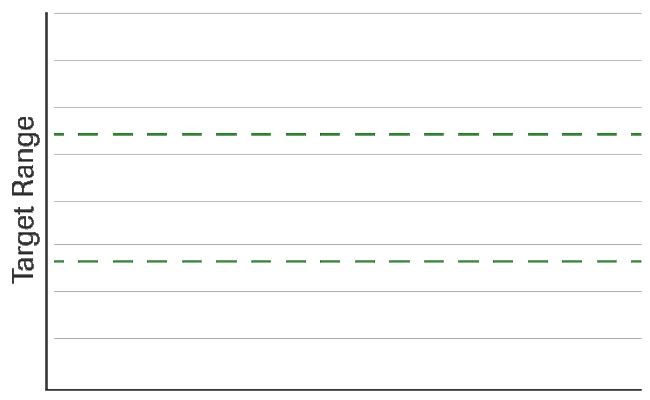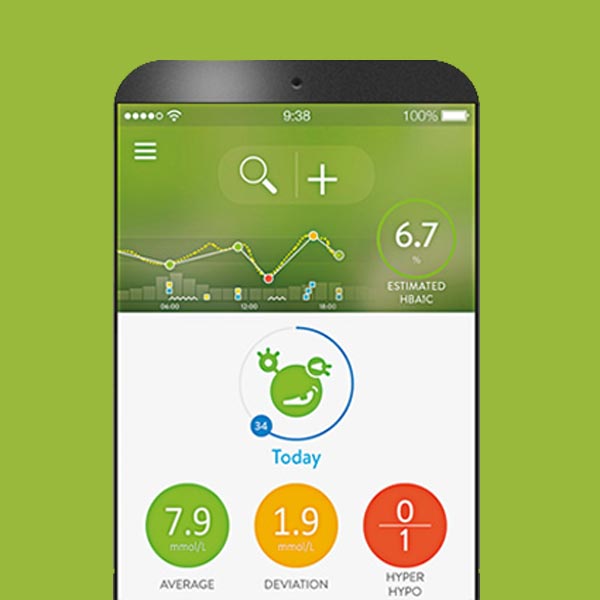Average blood glucose and the HbA1c test
Your HbA1c (also known as A1c or glycated haemoglobin) can give a general gauge of your diabetes management, because it provides an average blood glucose level over the past few months.
Unlike blood glucose readings using a finger prick test, which are reported as mmol/l, HbA1c is reported as a mmol/mol. For example, if you check blood glucose 100 times in a month, and your average result is 10.5 mmol/l this would lead to an HbA1c of approximately 66 mmol/mol (8.2%), which is above the recommended NICE targets.
What is HbA1c?
You should have your HbA1c checked by your healthcare professional at least once a year, sometimes more depending on your diabetes. The HbA1c test measures your average blood glucose levels by taking a sample of blood. This is then sent to a lab to analyse the results.
Here's how it works:
Sugar (or glucose) naturally attaches itself to cells as they move through your bloodstream. When this happens, the cell is considered "glycated”. Everyone (whether they have diabetes or not) has glycated blood cells. The more sugar you have in your blood, the more that sticks to the cells. These are permanent, however as red blood cells only last for 4 months, new ones are made. That is why your HbA1c can only give an average of blood glucose over the last 2-3 months.
The more glucose in your blood, the higher the percentage of glycated red blood cells you'll have, and the higher your HbA1c result will be.
How is HbA1c measured?
HbA1c was previously measured in the DCCT (Diabetes Control and Complications Trial) unit of percentage (%), but in 2009, changed to the IFCC (International Federation of Clinical Chemistry) unit of millimoles per mol (mmol/mol). This was to make the unit of measure standard worldwide1. This means you might see your result displayed differently if you have had diabetes for a long time, or you will see two results, one in mmol/mol and one in %.
Example HbA1c conversion:
| DCCT measurement (%) | IFCC measurement (mmol/mol) |
| 5.5% | 37 mmol/mol |
| 6.5% | 48 mmol/mol |
| 7.5% | 58 mmol/mol |
| 8.5% | 69 mmol/mol |
| 9.5% | 80 mmol/mol |
What should be my target HbA1c?
You should determine the right target level for you, together with your Healthcare Professional. This will depend on your type of diabetes therapy, how long you have had diabetes and any previous HbA1c results.
According to NICE guidelines2, if you are an adult, have type 2 diabetes and are on diet and exercise, or medication that doesn’t cause hypoglycaemia- your target would be an HbA1c of 48 mmol/mol (6.5%).
If you are an adult with medication that does cause hypoglycaemia (i.e. insulin) your target is an HbA1c of 53 mmol/mol (7%)2. Talk to your Healthcare Professional about the right goal for you.
HbA1c calculator
The calculation below is provided to illustrate the relationship between HbA1c and average blood glucose levels. This calculation is not meant to replace an actual lab HbA1c result, but to help you better understand the relationship between your test results and your HbA1c. Use this information to become more familiar with the relationship between average blood glucose levels and HbA1c.
*The eHbA1c calculated here is just an estimation based on the average blood glucose you have entered. It should not replace the HbA1c check carried out by your doctor and the result shown here may differ from the lab value you get. This calculation should not be used to make therapy decisions or changes. You can discuss with your healthcare professional how this approximate measurement could help you in your overall diabetes management.
Self-monitoring and HbA1c
HbA1c is important, but it's not a substitute for structured self-monitoring. Only regular blood glucose checks show you how meals, activity, medications and stress affect your blood glucose at a single moment in time, as well as over the course of a day or week.

Without regular self-checking to provide day-to-day insights, an HbA1c result can be confusing. Because it gives an average view, a person with frequent highs and lows could have an in-range result that is the same as someone with blood glucose consistently in target range.
This animation shows two examples of blood glucose variability where the HbA1c would be the same.
This is why self-monitoring blood glucose levels is valuable. Remember one blood glucose check in isolation will not tell you the whole story. Getting the results is one thing, but knowing what to do with them is key. Making the most of your data can help you to make better decisions, about your health, such as dietary choices and insulin doses.
The only way to get a complete picture of your blood glucose is by reviewing your day-to-day self-checks along with your regular HbA1c tests, and working closely with your Healthcare Professional to interpret the results. Find out more about blood glucose monitoring here.
Other tools
mySugr® app*
The free mySugr app is a digital logbook for keeping al your diabetes data in one place. It provides an estimated HbA1c level at a glance.
Accu-Chek Testing in Pairs tool
Testing in Pairs is a paper tool designed to help you see changes in your blood sugar before and after a specific meal, exercise, or other event.
Read moreReferences
- Diabetes UK. Change in measurement of HbA1c. Available at: https://www.diabetes.org.uk/about_us/news_landing_page/change-in-measurement-of-hba1c. Accessed January 3, 2023.
- National Institute for Health and Care Excellence. Type 2 diabetes in adults: management NICE guideline [NG28]. 2015. Available at: https://www.nice.org.uk/guidance/ng28/chapter/1-recommendations Accessed January 3, 2023
Sources
- Nathan DM, Kuenen J, Borg R, Zheng H, Schoenfeld D, Heine RJ. Translating the A1C assay into estimated average glucose values. Diabetes Care. 2008;31(8): 1473-1478. Available at http://care.diabetesjournals.org/content/31/8/1473.full.pdf. Accessed December 16, 2022.
- Diabetes UK. What is HbA1C? Available at: https://www.diabetes.org.uk/guide-to-diabetes/managing-your-diabetes/hba1c Accessed January 2, 2023.
- Tylee TS, Trence DL. Glycemic variability: looking beyond the A1C. Diabetes Spectrum. 2012;24(3): 149-153. Available at: http://spectrum.diabetesjournals.org/content/25/3/149.full. Accessed December 16, 2022.
* The mySugr Bolus Calculator is licensed for people with diabetes over the age of 18 years. The mySugr logbook is licensed for people with diabetes over the age of 16 years.


